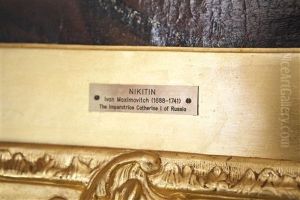Ivan Nikitich Nikitin Paintings
Ivan Nikitich Nikitin was a distinguished Russian portrait painter who emerged as one of the early significant figures in Russian art during the transitional period from the 17th to the 18th century. Born around 1680, Nikitin's origins remain somewhat obscure, but his talent propelled him into the limelight of the Russian art scene, particularly during the reign of Peter the Great. Nikitin is credited with introducing a more realistic and individual approach to portraiture in Russia, diverging from the traditional, highly stylized icon painting that had dominated Russian art for centuries.
Nikitin's career took a significant turn when he was sent by Tsar Peter I to study painting in Western Europe around the early 18th century. This experience exposed him to the Baroque style, which was then prevalent in European art. Upon his return to Russia, Nikitin brought with him a refined technique and a new sensibility, which were evident in his portrayal of the Russian elite. His works from this period are characterized by their sophisticated use of light and shadow, a keen attention to detail, and a psychological depth in the depiction of his subjects, which was unprecedented in Russian art at the time.
Among Nikitin's most famous works are his portraits of Peter the Great and other members of the Russian nobility, which have been praised for their vitality and insight into the character of his sitters. His portrait of the Hetman of Ukraine, Ivan Mazepa, is another masterpiece, showcasing his skill in rendering textures and fabrics, as well as his ability to capture the dignity and complexity of his subjects. Despite his significant contributions to Russian art, Nikitin's later years were marred by controversy and he died in relative obscurity in 1742. Nevertheless, his legacy as a pioneer of Russian portraiture and his role in the Westernization of Russian art have secured his place in the annals of art history.







